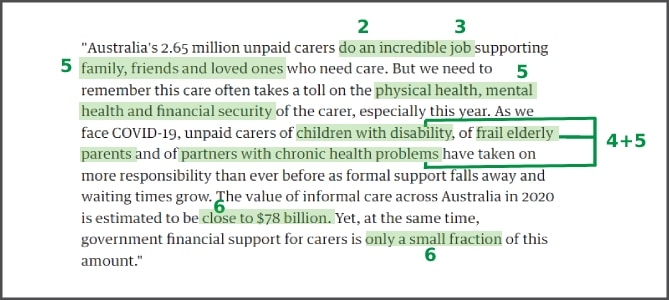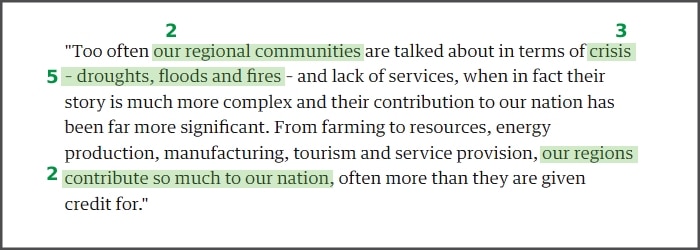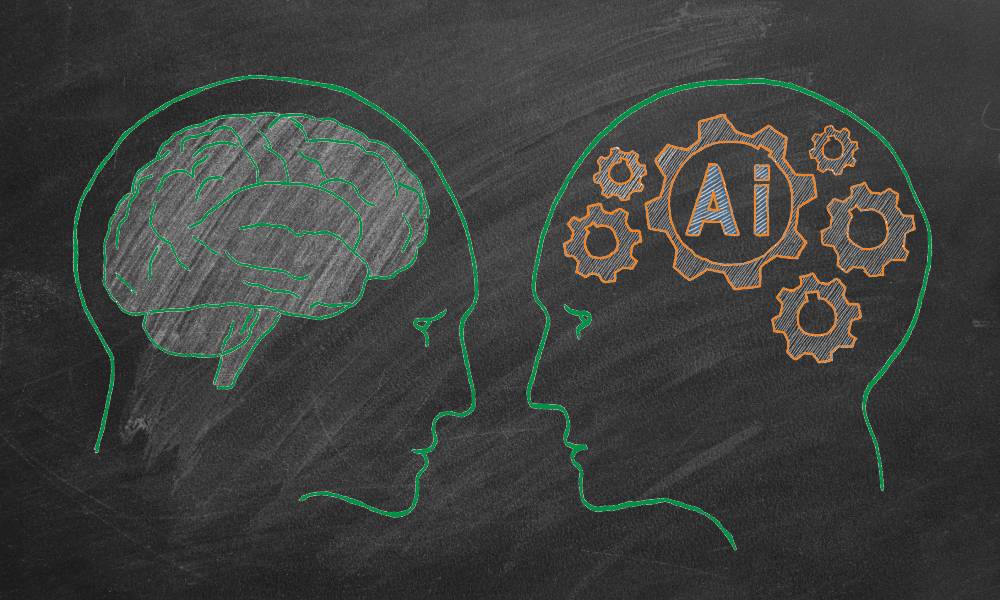It’s easy to say that AI copywriting tools can’t write as well as humans. There are plenty of articles making that point. There are fewer of them which give concrete examples of the actual different. So today I’m taking a look at AI vs human copywriting, sharing some of the ways they are different.
I took my examples from a recent article in the Guardian asking readers to distinguish between AI writing and extracts from political speeches. I got 5 out of 6 tests right. The Guardian had done the hard work of collating AI and human copy on the same topics, and I’d analysed them. No good reason to start all over again, so I started from there.
Here are two ‘paragraph pairs’ – in each case, one is AI writing and one is by a politician. (Or you can check out all six pairs of copy in the original article.)
Two pieces on preserving Sydney’s beaches:


And two on dental care:

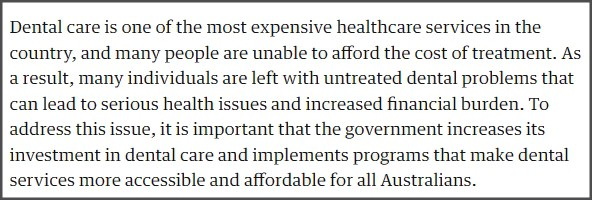
Could you tell which were AI vs human language?
At first glance, they all seem very human and coherent. Dig a little deeper, though, and the differences start to show. Here are the top 7 differences I found.
1. Purpose
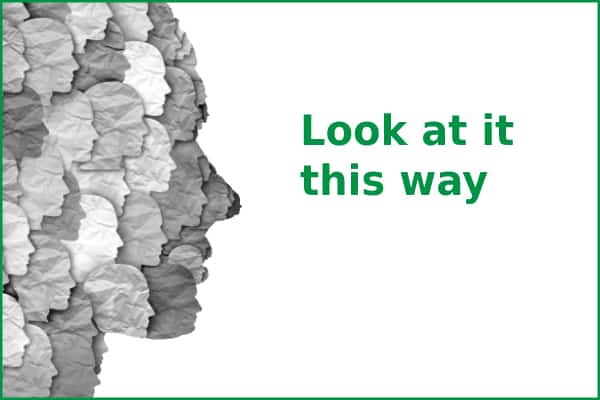
Imagine you’re a politician speaking about dental care. You’re not just informing people of the current state of play. You’re not just explaining your party’s policy. You have a purpose. Either you want to make people think better of you and your party, or you want to make them think less of the other party.
With that in mind, look at the use of the word ‘this‘ in ‘this government has no idea and no comprehensive plan. Australians are suffering because of this government’s lack of commitment to decent dental care.‘ Why say ‘this government’ rather than ‘the government‘?
‘This government‘ pinpoints a specific government – the current one – and attaches the lack of ideas, plans and commitment to the party currently in power. It also neatly implies a potential alternative ‘that government‘ – the one you could have placed in power at the last election, or which you could vote in at the next one. This very human usage is aiming to influence as well as inform.
2. Building a connection

One thing which really helps in influencing is to build a connection. If your audience identify with you – or feel as if you identify with and understand them – it increases connection, trust and the likelihood that they’ll support what you’re proposing.
When a human says or writes something like, ‘From Palm Beach to Manly, from Bondi to Little Bay, and across Pittwater to Patonga’, it conveys so much more than a simple phrase like ‘Sydney’s beaches’.
- It demonstrates that the speaker knows the beaches of Sydney, well enough to name many of them.
- Residents who live near the named beaches, or frequently visit them, will be more engaged by this language. Dale Carnegie advises that we should talk ‘in terms of the the other’s interests‘ – that’s exactly what this level of specificity does.
3. Evoking emotion
Emotion is of course at the centre of influence. Words often tug a little bit at the heartstrings, evoke emotional responses.
Describing the beaches as ‘one of the most beautiful coastlines in the world‘ encourages an audience of Sydneysiders to take pride in their beaches, to feel great because of them. Just the emotion you want if you’re seeking funds to preserve them! This passage doubles down on that emotion with phrases like ‘all-round stunning views‘ and ‘a wonder to behold’. The other passage, written by ChatGPT, is more fact-based and balanced. It lacks that ‘wow‘ factor.
4. Specific detail
I’ve mentioned this a few times already. People love specific details. It helps them visualise what’s behind the words. That’s why those beaches work so well. They’re real places, including some of the most iconic and most visited beaches in the city.
Look at the pieces on dental care too. Consider the difference between ‘untreated dental problems that can lead to serious health issues‘ and ‘the risk of cardiovascular disease and stroke’. A ‘serious health issue’ is vague, whereas we have an idea what a heart attack or stroke looks like – and may well know someone who’s been affected by one or the other. The specific detail is what creates connection and engagement.
5. Rhetorical devices – the group of three
I started off looking at intent or purpose in writing. Gradually I’ve moved to look at the techniques used to achieve that purpose. And some of those, of course, are from classical rhetoric. One very common example is the group of three, or tricolon. It’s one of the most powerful rhetorical devices out there. It works so well and is so popular that four out of six of the human pieces of prose the Guardian quotes have groups of three.
In the examples I’ve chosen to focus on, we come back to those beaches. There are six of them, but they are clearly structured into three pairs of two. This is part of what gives the passage its music and rhythm, what makes it human.
6. Rhetorical devices – contrast

If you only quote two things in rhetoric, they are often contrasting or contradictory, to create more emphasis. I’ve already mentioned the implied contrast between ‘this government’ and ‘that [alternative] government’. A lovely example in one of the other passages the Guardian talks about how during Covid travel agents were ‘sending money out the door‘ with ‘zero money coming in‘. These two phrases reinforce each other beautifully. It’s a very human way of creating emphasis.
7. Rhetorical devices – alliteration
Another common and effective rhetorical device – and once again, we find it with the beaches: ‘from Bondi to Little Bay, and across Pittwater to Patonga‘. (Note that B and P are also very closely related sounds, so this flows even better.)
Summing up
I hope this gives you some idea – and some practical examples – of the differences between AI and human use of language.
When I first read the article, I identified the human writing 5 out of 6 times. I knew instantly that the beaches were human – the rhythm and flow of that sentence is excellent. You can see how it used so many ways to connect and engage – specificity, groups of three, alliteration, all combined. For some of the other pieces I found it harder to pinpoint how I knew. That’s what led me to analyse more deeply, then to write this post.
I went through all the Guardian’s original posts looking for examples of these human aspects of language. You can see what I found in the images below.
More important than any specific detail, the main thing I noticed was that the AI pieces tended to be more abstract and ‘academic’ in tone. They felt as it someone were speaking in an official capacity, removing personal preference, stories and examples. There’s nothing actually wrong with the AI, but when you compare it to what humans produce, it hasn’t got the same personality. I know there are ways to get AI to write ‘in the style of’, but even then the originality falls a little flat.
The key question for me is, if the AI blandness is apparent in pieces which are just a paragraph long, what happens when you use it for an entire speech or an entire blog post? It’s hard to see how it will stay engaging. Or persuade.
So if you want engaging writing on your website, it might still be worth asking a human copywriter!
Check out the annotated images below to see just how much more meaning humans cram into their words. (The numbers refer to the techniques I listed above, and that very first ‘8’ refers to metaphor, which didn’t make the cut in my two examples.)

